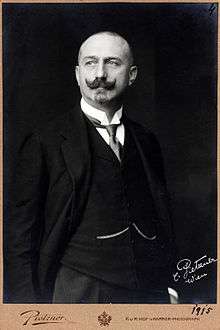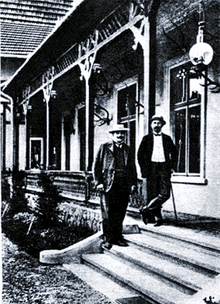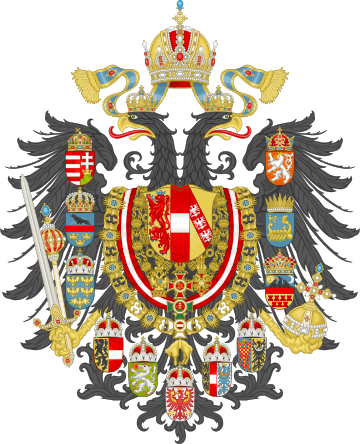Prince Konrad of Hohenlohe-Schillingsfürst
| Durchlaucht Konrad zu Hohenlohe-Schillingsfürst | |
|---|---|
 Prince Konrad zu Hohenlohe in 1915 | |
| 20th Minister-President of Cisleithania | |
|
In office 2 May 1906 – 2 June 1906 | |
| Monarch | Francis Joseph I |
| Preceded by | Paul Gautsch von Frankenthurn |
| Succeeded by | Max Wladimir von Beck |
| Personal details | |
| Born |
16 December 1863 Vienna, Austrian Empire |
| Died |
21 December 1918 (aged 55) Kammern im Liesingtal, Styria |
| Spouse(s) | Countess Franziska of Schönborn-Buchheim |
| Religion | Roman Catholic Church |
Konrad Maria Eusebius Prinz zu Hohenlohe-Waldenburg-Schillingsfürst (16 December 1863 – 21 December 1918) was an Austrian aristocrat and statesman. He briefly served as Prime Minister of Austria (Cisleithania) in Austria–Hungary in 1906.
Life
Prince Konrad was born in Vienna, the son of Prince Konstantin of Hohenlohe-Schillingsfürst (1828–1896), k.u.k. Chief Intendant and General of the Cavalry, and his wife Marie née Princess of Sayn-Wittgenstein-Berleburg (1837–1920), a daughter of Carolyne zu Sayn-Wittgenstein known for her liaison with Franz Liszt. By his father, Konrad was a nephew of Duke Victor I of Ratibor, of Prince Chlodwig of Hohenlohe-Schillingsfürst, Chancellor of Germany from 1894 to 1900, and of Cardinal Prince Gustav Adolf of Hohenlohe-Schillingfürst.
Prince Konrad attended the Schottengymnasium and went on to study law at the University of Vienna from 1883 to 1887. He entered the Cisleithanian civil service in Prague and later worked at the k.k. Ministry of the Interior. Appointed district officer (Bezirkshauptmann) in Teplitz-Schönau, Bohemia, he proved to be a man of conciliation and social justice, when he reached the settlement of a miners' strike and granted the permission to the performance of Hauptmann's socially critical play The Weavers, which earned him the nickname "Red Prince".
In 1888 Prince Konrad married Countess Franziska of Schönborn-Buchheim (1866-1937). One of their six children, Princess Franziska of Hohenlohe-Waldenburg-Schillingsfürst (1897-1989), by her marriage with Archduke Maximilian Eugen of Austria became sister-in-law of Archduke Karl Franz of Austria, the last Emperor of Austria.

In 1903/04, Prince Konrad served as k.k. stadtholder of the Bukovina in Czernowitz, and from 1904 as stadtholder of the Austrian Littoral in Trieste. A confidant of the heir to the throne Archduke Franz Ferdinand, he was appointed Minister-President of Cisleithania on 2 May 1906, in order to push through an electoral reform granting universal male suffrage to the Imperial Council, whereby his predecessor Paul Gautsch von Frankenthurn had failed. Prince Konrad tried to mobilize the votes of the Italian representatives in the Council against a "Slavic" block, but did not succeed in achieving a majority. He resigned within one month and returned to Trieste. It was left his successor Max Wladimir von Beck to have the new electoral law passed by deputies.
Prince Konrad remained stadtholder of the Littoral until 1915. He had to cope with rising Italian irredentism and his measures of centralization in favour of the Vienna government met with strong protest. When the Kingdom of Italy threatened to join the Entente Powers, he resigned and temporarily joined the Imperial-Royal Landwehr forces at the Eastern Front. Back in Vienna he assumed the office of k.k. Minister of the Interior on 30 November 1915 in the cabinet of Minister-President Count Karl von Stürgkh. As minister, he evolved plans of re-arranging the Austro-Hungarian dual monarchy into a federation of four major states: Austria proper, Hungary, Poland (Galicia), and "Illyria" (i.e. Croatia-Slavonia, Bosnia and Herzegovina, and Dalmatia). However, those plans were rejected mainly by Hungarian politicians.
Prince Konrad resigned as Interior Minister on 31 October 1916, shortly after Minister-President Stürgkh was assassinated by Friedrich Adler. From 2 December 1916 he served for three weeks as Joint Finance Minister of Austria-Hungary, before he was succeeded by Stephan Burián von Rajecz on 22 December. Also from 2 December he was member of the Austrian House of Lords until its dissolution in November 1918. With the end of World War I he retired from politics and died shorlty afterwards while hunting in Kammern im Liesingtal, Styria.
External links
See also
- Konstantin zu Hohenlohe-Schillingsfürst (de)
- Marie zu Hohenlohe-Schillingsfürst (de)
- Hohenlohe-Waldenburg-Schillingsfürst, Hohenlohe-Schillingsfürst
